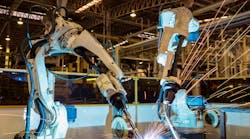As companies are using robotic technologies to perform dangerous or repetitive tasks, employees are now working with robots more often. The World Robotics 2021 Industrial Robots report estimates currently that more than 310,000 industrial robots now operate in U.S. factories. While the robots can provide benefits to the workplace, they also introduce new hazards such as struck-by/caught-between, crushing and trapping, electrical, hydraulic, pneumatic and environmental.
Back in 2017, the U.S. Department of Labor’s Occupational Safety and Health Administration, National Institute for Occupational Safety and Health and the Association for Advancing Automation (formerly the Robotic Industries Association) formed an alliance to share technical knowledge, improve awareness about workplace hazards and appropriate safeguards, and identify needed research on the use of traditional industrial and emerging collaborative robotic technologies.
Recently, the alliance updated and expanded a chapter in the OSHA Technical Manual on Industrial Robot Systems and Industrial Robot System Safety. Updates include technical information on the hazards associated with industrial and emergent robot applications, safety considerations for employers and workers, and risk assessments and risk reduction measures.
“Our trade association has made the safety of people working around robots our top priority for nearly four decades,” said Association for Advancing Automation President Jeff Burnstein, in a statement. “That’s why we developed R15.06 – the first industrial robot safety standard – in the early 1980s, and have regularly updated the standard as technology has improved. We are honored to be a part of the alliance with OSHA and NIOSH, to work together to get this vital information on safety into the hands of robot system users.”
The manual serves to guide OSHA compliance officers as they perform inspections at facilities with robotic systems, and provides a technical resource for safety and health professionals overseeing the use of robotic systems in workplaces.
“Robot use will continue to expand, and employers have a responsibility to assess the hazards these new applications may introduce, and implement appropriate safety controls to protect the workers who operate and service them,” said Assistant Secretary of Labor for Occupational Safety and Health Douglas Parker, in a statement.
